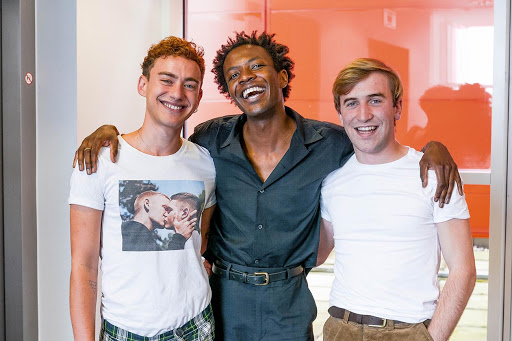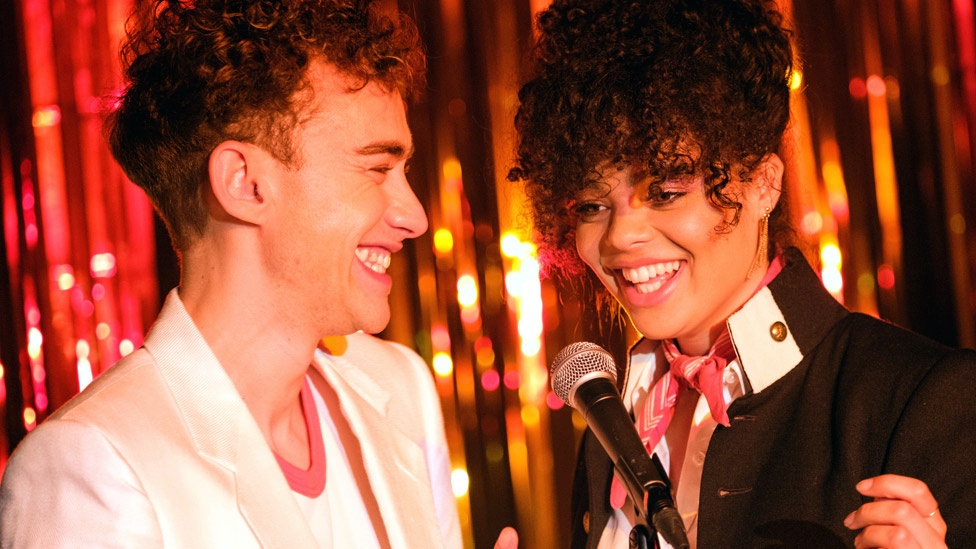The 2021 blockbuster drama It’s a Sin, created by queer screenwriter Russell T. Davies, explores the lives of young people affected by the emergence of the HIV and AIDS epidemic in the 1980s. The Gryphon music editor Fern McErlane takes a close look at the eighties-inspired soundtrack, and how music is used within the show. Warning: this article contains spoilers…
It’s a Sin has taken over the internet by storm, and rightly so- it’s Britain’s very first TV show about the emergence and spread of the HIV and AIDS epidemic. With the show beginning in the early ’80s, focusing on three boys- Ritchie, Colin, and Roscoe- and their found family in London, it’s a close-to-the-bone representation of the experiences of the LGBTQI+ community during this time. The soundtrack is liberally star-studded (which must have cost producers highly in royalty fees), with songs from the likes of Blondie, Joy Division and Kate Bush making appearances. It features, of course, classic queer hits; it’s no surprise that much of the music during the earlier episodes is exuberant and celebratory, pop and club hits from the era to set the party scene of London. However, much of the music chosen is thematic and ‘uncool’- from artists who gained cult gay followings for their acceptance of the community, such as Hazell Dean and Kelly Marie. Music is never used simply as background noise, or to fill up space; the songs in the show are mainly non-diegetic, and deliberately timed to aurally impact the audience, the lyrics and emotions of each song often pairing up with what’s happening onscreen.
With the show’s timeline beginning in September 1981, the very first track to play is the peppy ‘Enola Gay’ from Orchestral Manoeuvres In The Dark. Tonally upbeat, full of hope and promise, it accompanies our introduction to the character Ritchie as he hastily packs his pornographic mags and sets off for university in London. Yet, despite its sunny sounds, this song carries anti-war sentiments, referencing the atomic bombing of Hiroshima by the US Air Force, carried out in part by an aircraft named Enola Gay. This stark juxtaposition of light tone and dark content, happiness and horror, extends across the series as It’s A Sin’s characters develop from fresh-faced dancing teens, into adults faced with the reality of the growing HIV and AIDS epidemic.
At the show’s highest points, the music of the LGBTQI+ club scene is expertly selected. There’s the musical comedy of Ritchie’s sexual liberation through club hookups in episode one; this gratuitous, montaged shagathon is soundtracked by racing swells of classical orchestral grandeur. Most notably and hilariously mixed in is Rossini’s ‘William Tell Overture’, synonymous with masculine sport and racing, which battles with club-drum beats in this eighties-tastic rendition by the Royal Philharmonic Orchestra (Hooked on Classics, Parts 1 & 2) as Ritchie romps onscreen. It’s a gloriously campy celebration of sex and gay clubbing culture. For the show’s creator, Russell T. Davies, this particular musical interlude is crucial: in an interview, he revealed that he “really wanted to include songs that were not cool in the 80s but which I loved. I had the Hooked on Classics album; I didn’t think it was high art, but I loved it […] But also, I thought it was hilarious. It’s a sequence that I wanted to make people laugh. There’s a joy and glee to that, which sums up the whole tone of the show.” (interview by Alim Kheraj, The Guardian)
There are moments of slyly winking dramatic irony from the director, Peter Hoar, as music serves as a poignant foil to the action onscreen. On the morning of Roscoe’s sister’s wedding – which he cannot truly attend, due to his family estrangement – what else could be played other than the rangy sounds of Joy Division’s ‘Love Will Tear Us Apart’? In Davies’ own words: “Also, just say the title in your head. What a title. It’s exactly what’s happening. You could call the show Love Will Tear Us Apart.” Dramatic tonal clashes occur often: Eurythmics’ peppy ‘Sweet Dreams (Are Made of This)’ is layered over Ritchie checking his body obsessively for signs of AIDS. At other times, the song choices are cheesy and self aware- ‘Kids in America’ (by Kim Wilde) blasts ironically over a montage of Colin in New York. It’s not only within the show’s action that music is artfully used; the song choices for the credits are strikingly deliberate- at the show’s first incredibly low point, the end of episode two, Laura Brannigan’s ‘Gloria’ rings through- directly after the death of character Gregory, otherwise known as Gloria.

Music is the key focal point of the blossoming friendship between Ritchie and Jill; a glorious recurring subplot feature is their karaoke-style singing as Tozer and Baxter (or Baxter and Tozer), with their pubs-and-clubs performances serving to build up their work history. Their very first song together is a gorgeous a cappella cover of Barry Manilow’s ‘One Voice’- in smiling unison they intone, “If only, one voice, would start it on its own / We need just one voice facing the unknown / And then that one voice would never be alone”. It’s a clear testament to the power not only of the deepening friendship between Jill and Ritchie, but for their whole community; a song about searching for connection. Ritchie’s parents, nearby, edgily debate the rumours that Manilow is ‘queer’. Their next performance is comic relief, a sugary sweet rendition of Carmel’s ‘More, More, More’ complete with synchronised jazz-hands; yet this is now marred by the overarching presence of AIDS, as alongside the music we see Jill scrubbing herself in the shower for fear of germs. The pair’s final duet, a jubilant, harmonious rendition of ‘Only You’ by The Flying Pickets, is served up surrounded by their friends. It is one of the last times they seem truly happy.
The most poignant moment of their friendship, in the final episode, shows the culmination of their love and trust; Jill is now looking after Ritchie as he suffers from the physical effects of AIDS. It is brilliantly set to Kate Bush’s ‘Running Up That Hill (A Deal With God)’; lyrically, it focuses on the relationship between a man and woman and how, in Bush’s own words, “briefly, if they could make a pact with God to exchange their roles… they would understand each other better and would resolve their differences.” Its significance here is similar; with the epidemic now affecting the group of friends significantly, Jill is a caring soul who would switch their places if she could. She’s based on a real person, a friend of Davies’- Jill Nalder- and appears in the show playing her namesake character’s mother.

It’s impossible to ignore the overarching presence of the Pet Shop Boys in this show, with the title – It’s A Sin – lifted directly from that of a track from their 1987 album Actually. A campy, theatrical single with winkingly choral undertones, it was initially about the effects of a Catholic upbringing- but translates neatly into describing the experiences of gay people in the face of homophobia. It appears briefly in episode four, when Ritchie returns home to the Isle of Wight after his AIDS diagnosis. Yet, the cover version by star actor Olly Alexander (who plays one of the show’s protagonists, Ritchie Tozer- and is also popularly known as the vocalist for synth-pop trio Years & Years) is much more sombre. With mournful, pared-back keys, it matches the atmosphere of fear, anxiety and suffering developed at this point in the show. Alexander’s yearning vocal delivery is haunting: “When I look back upon my life / It’s always with a sense of shame / I’ve always been the one to blame / For everything I long to do.” It’s a direct reflection of the shame and stigma surrounding HIV and AIDS in It’s A Sin, a legacy that still remains today; Davies strives to negate this, showing us that none of his characters deserved to suffer due to their sexuality, much like how the very real people affected by AIDS were treated- as if their love were a sin. It’s important to keep their memory alive.
Music is used to celebrate and to comfort, to support and highlight the LGBTQI+ community within It’s A Sin. Each song choice is important and poignant in its own way. In director Peter Hoar’s own words:
Header image credit: Channel 4.

